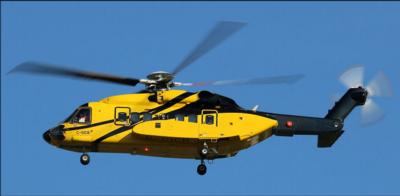Offshore Helicopter Crew Recovers From Inadvertent Descent Near Sable Island, Nova Scotia
It really doesn't get much closer than this...

In its investigation report (A19A0055), the Transportation Safety Board of Canada (TSB) found that, while conducting a visual approach to an offshore helideck platform in instrument meteorological conditions (IMC), a Sikorsky S-92A helicopter inadvertently entered a low-energy state descent. The pilots were able to stop the descent and regain control within approximately 13 feet of the water.
On 24 July 2019, at 11:54 Atlantic Daylight Time, a Canadian Helicopters Offshore (CHO) Sikorsky S-92A helicopter departed Halifax/Stanfield International Airport, Nova Scotia, on an instrument flight rules flight. The helicopter was headed to the Thebaud Central Facility, an offshore platform southwest of Sable Island, Nova Scotia, with two pilots and 11 passengers on board. Two instrument approaches were attempted at the platform; however, landing was not possible due to low clouds and poor visibility.
Following the second approach, the flight crew acquired visual contact with the platform, visible above a fog layer, and elected to carry out a visual approach. Shortly after they commenced the visual approach, a high-rate-of-descent and low-airspeed condition developed in low-visibility conditions. During the descent, the helicopter’s engines were over-torqued, reaching a maximum value of 146%. The flight crew regained control of the aircraft at approximately 13 feet above the water. During the subsequent hand-flown climb, a second inadvertent descent occurred but the situation was rectified in a timely manner. The aircraft then returned to Halifax/Stanfield International Airport without further incident. The extent of the helicopter’s damage is unknown, as it has been removed from service. There were no injuries.
The investigation determined that instrument meteorological conditions existed at the time of the occurrence, which created a degraded visual environment that was highly conducive to spatial disorientation and provided inadequate cues to permit a visual approach to the Thebaud Central Facility. In an attempt to complete their assigned task within self-imposed time constraints, the pilots’ decision-making process was influenced by their past experience and ease with each other. As a result, they attempted a non-standard visual approach in a degraded visual environment, without thoroughly considering the risks or alternative options.
The investigation also found that CHO’s standard operating procedures provided flight crews with insufficient guidance to ensure that approaches were being conducted in accordance with industry-recommended stabilized approach guidelines.

The pilot flying’s workload increased during the approach when he depressed and held the cyclic trim release button, which contributed to the control difficulties that were encountered. If manufacturers’ flight manuals and operators’ standard operating procedures do not include guidelines for the use of the cyclic trim release button, it could lead to aircraft control problems in a degraded visual environment due to the sub-optimal use of the automatic flight control system.
The investigation also found that the S-92A’s enhanced ground proximity warning system (EGPWS) provides no warning of an inadvertent descent at airspeeds below 50 knots when the landing gear is down. As a result, the EGPWS did not alert the flight crew of the impending risk of controlled flight into terrain. Since there is currently no requirement for commercial helicopters to be equipped with an EGPWS, nothing prevents a manufacturer and/or operator from inhibiting modes of an installed EGPWS, which in turn degrades the system’s capabilities.
In 2016, the TSB issued Recommendation A16-10 calling for terrain awareness and warning systems for commercial helicopters that operate at night or in IMC. Until EGPWS/helicopter terrain awareness and warning systems become mandatory for Canadian commercial helicopters that operate at night or in IMC, flight crew and passengers aboard these flights are at increased risk of controlled flight into terrain.
Following the incident, CHO took several safety actions and subsequently requested the suspension of its air operator certificate since it no longer had any aircraft in its possession, nor did it have any ongoing contracts.
Canada's TSB notes that it is an independent agency that investigates air, marine, pipeline, and rail transportation occurrences. Its sole aim is the advancement of transportation safety. It is not the function of the Board to assign fault or determine civil or criminal liability.
 ANN's Daily Aero-Term (04.25.24): Airport Rotating Beacon
ANN's Daily Aero-Term (04.25.24): Airport Rotating Beacon ANN's Daily Aero-Linx (04.25.24)
ANN's Daily Aero-Linx (04.25.24) Klyde Morris (04.22.24)
Klyde Morris (04.22.24) Airborne 04.24.24: INTEGRAL E, Elixir USA, M700 RVSM
Airborne 04.24.24: INTEGRAL E, Elixir USA, M700 RVSM Airborne 04.22.24: Rotor X Worsens, Airport Fees 4 FNB?, USMC Drone Pilot
Airborne 04.22.24: Rotor X Worsens, Airport Fees 4 FNB?, USMC Drone Pilot




